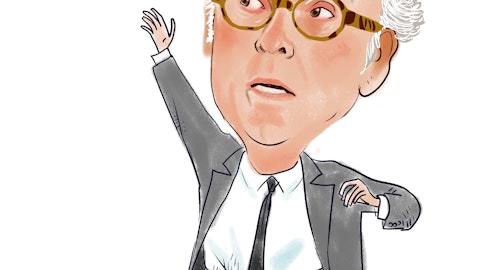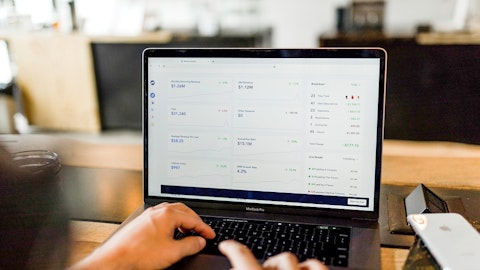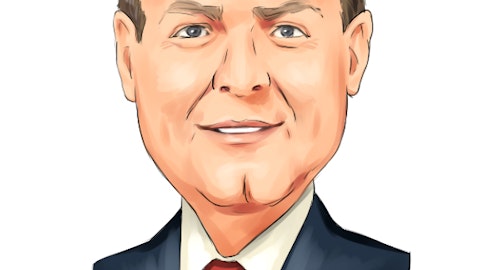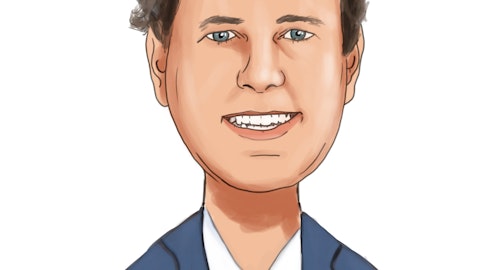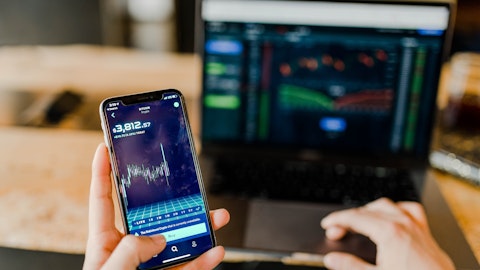WestRock Company (NYSE:WRK) Q1 2023 Earnings Call Transcript February 1, 2023
Operator: Good morning and welcome to the WestRock First Fiscal Quarter 2023 Earnings Call. All participants will be in listen-only mode. Please note this event is being recorded. I’d now like to turn the conference over to Rob Quartaro, Senior Vice President of Investor Relations. Please go ahead.
Rob Quartaro: Good morning and thank you for joining our first fiscal quarter 2023 earnings call. We issued our press release this morning and posted the accompanying presentation to the Investor Relations section of our website. They can be accessed at ir.westrock.com or via a link on the application you’re using to view this webcast. With me on today’s call are WestRock’s Chief Executive Officer, David Sewell and our Chief Financial Officer, Alex Pease. Following our prepared comments, we will open the call for a question-and-answer session. During today’s call, we will be making forward-looking statements involving our plans, expectations, projections, estimates, and beliefs related to future events. These statements involve a number of assumptions, risks, and uncertainties and that could cause actual results to differ materially from those we discussed during the call.
We describe these assumptions, risks and uncertainties in our filings with the SEC, including our 10-K for fiscal year ended September 30th, 2022. We will also be referencing non-GAAP financial measures during the call. We have provided reconciliations of these non-GAAP measures to the most directly comparable GAAP measures in the appendix of the slide presentation. As mentioned previously, the slide presentation is available on our website. With that, I’ll now turn it over to you, David.
David Sewell: Thank you, Rob and thank you all for joining our earnings call today. This morning, I’ll provide an overview of our fiscal first quarter results, followed by a review of our strategy, and progress on our transformation. Then I’ll turn it over to Alex, who will review our segment performance in more detail review our adjusted free cash flow, and provide our outlook for the fiscal second quarter. We will then move to Q&A. Turning to our first quarter results on slide three. Net sales were comparable to prior year at $4.9 billion and consolidated adjusted EBITDA declined 4% to $652 million. Adjusted EPS was $0.55, a decrease of 15% compared to the prior year quarter, and the company generated $30 million of adjusted free cash flow.
It’s important to note that consolidated adjusted EBITDA was negatively impacted by $119 million due to economic downtime and weather disruptions. Pension and foreign exchange rates also negatively impacted our year-over-year consolidated adjusted EBITDA growth by $57 million combined. As we anticipated, the first quarter operating environment saw continued inventory rebalancing, elevated inflation, and shifting consumer spending. These trends primarily impacted external containerboard demand as well as our Corrugated Packaging segment. However, Corrugated Packaging improved quarter-over-quarter with North American packaging shipments up 2% and to 373 million square feet per day. We continue to balance our supply with our customers’ demand, and we incurred 356,000 tons of economic downtime during the quarter.
Our Consumer Packaging business and external paperboard continue to see consistent demand supported by exposure to several resilient end markets and adoption of our plastics replacement solutions. During the quarter, our consumer business was negatively impacted by weather disruptions and other items in several of our mills. However, we continue to see healthy demand and backlogs. The resiliency of our consumer business illustrates the benefit of our diversified business model and differentiates us in the market. Longer term, it also positions us well to capture more share of wallet as we are the only paper and packaging company able to offer a full range of packaging solutions, including machinery and automation. Corrugated Packaging adjusted EBITDA margins, excluding trade sales, were 14.2%, an increase of 70 basis points.
Consumer Packaging adjusted EBITDA margins were 15.1%, an increase of 20 basis points. Both Corrugated and Consumer margins benefited from strong year-over-year pricing. We are continuing to implement previously published price increases in our consumer business, which should continue for several more months. Global paper margins declined 320 basis points to 14% as inventory rebalancing and softer demand pressured results. Distribution adjusted EBITDA margins increased 140 basis points to 3.4%, primarily driven by favorable selling price and mix. We ended the quarter with net leverage of 2.35 times, slightly above our targeted range of 1.75 times to 2.25 times. We intend to use proceeds from the expected sale of our stake in RTS and our Chattanooga Mill as well as our free cash flow to return leverage to our targeted range over time.
We remain focused on executing our transformation and striving toward the goals we outlined in our Investor Day last May, recognizing the uncertain macroeconomic environment. We see significant opportunity to drive productivity, increase our margins and improve our return on invested capital. We will continue to leverage our robust cash flow to invest in growth, manage our leverage and return capital to shareholders. Before moving to an update on our transformation initiatives, I’d like to highlight that for the third consecutive year, WestRock was included in the Dow Jones Sustainability North America Index in recognition of our commitment to sustainable business practices. The index recognizes the top 20% of sustainability performance among the 600 largest US and Canadian companies.
Sustainability is core to what we do at WestRock, and we’re proud to be recognized for our efforts. And I’d like to thank our 58,000 team members for living our values in everything they do. Turning to Slide 4. Last May, we communicated the four key pillars of our transformation strategy, and we continue to make progress in each of these areas. First, leveraging the power of One WestRock. Given WestRock’s broad capabilities and scale, we are uniquely positioned to deliver value to our customers and serve their packaging needs. An ongoing example of this is our relationship with Molson Coors. Through our partnership, Molson Coors is replacing their use of plastic rings with our cluster pack packaging and automation solution. Molson Coors estimates this solution will eliminate over 1.7 million pounds of plastic waste annually by 2025.
The complementary relationship between our machinery business and packaging serves our customers well, creates deeper relationships, and drives organic growth. We now have over 5,100 machines in our installed base and it continues to grow. We see strong demand for our machinery solutions with backlogs of 12 months as of the end of the quarter. Our next pillar is innovating with a focus on sustainability and growth. We are investing in innovative solutions to help our customers meet their sustainability targets and displace plastic packaging with more than 225 innovation projects in development. More than 30 of those projects are related to plastics replacements. Our plastics replacement revenue continues to grow and is currently estimated at a $365 million run rate and we are targeting increasing that to more than $700 million in run rate revenue by fiscal 2025.
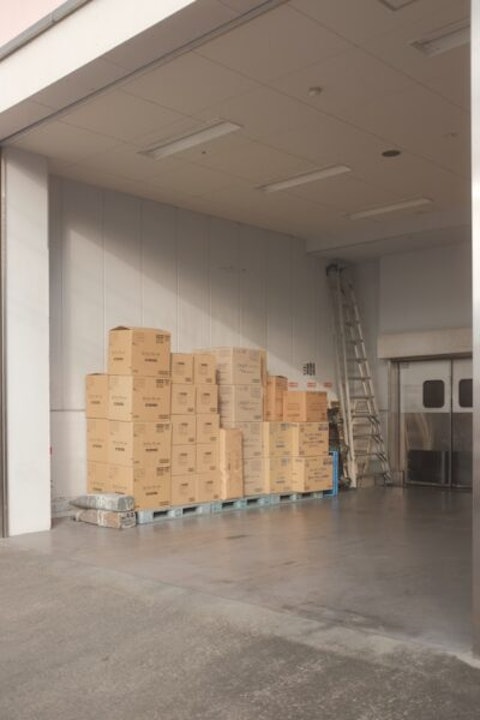
Photo by Mak on Unsplash
Our third pillar is relentless focus on margin improvement and increasing efficiency. We are executing on our productivity initiatives and we are on track to achieve $250 million in cost savings in fiscal 2023. These initiatives are driving savings through logistics and planning optimization, centralized procurement, SG&A reductions, and efficiencies in our mill and converting network. We continue to see significant cost-saving opportunities beyond fiscal 2023 and we remain focused on unlocking these savings to expand our margins. And finally, executing disciplined capital allocation. We remain focused on using our cash flow to drive value through our disciplined capital deployment strategy. Last year, we invested more than $860 million to maintain and improve our assets.
We’ve increased our dividend over 37% in the last seven quarters, while also repurchasing more than $700 million of our stock. We are also continuing to refine our portfolio to focus on the most attractive markets, reduce volatility, and improve our return on invested capital. Last year, we permanently shut capacity in higher-cost facilities in Panama City and St. Paul, enabling us to redirect significant capital investment toward better use in other assets. In December, we closed on the sale of two non-core URB mills and we continue to work toward closing on the sale of our stake in RTS and our Chattanooga mill, which remains subject to regulatory approval. We also recently completed our Grupo Gondi acquisition, which complements our North American footprint and increases our exposure to the attractive Latin America market.
The IMF projects the strategically important market will grow more than 50% faster than the United States, driven by economic growth and export product expansion in produce, protein, and industrial goods. In addition to attractive financial returns, Grupo Gondi’s high-quality assets bring us closer to many of our large multinational customers operating in the region. Grupo Gondi is already contributing to our growth, with adjusted EBITDA of $17 million since the acquisition closed in December and its full year results were in line with expectations. The results for Grupo Gondi are included in other unallocated this quarter given the timing of the closing and we are near finalizing how we will report it longer term. I’ll now turn it over to Alex to discuss our segment results in more detail.
Alex Pease: Thank, David. Moving to our consolidated quarterly results on Slide 5. The first quarter net sales were roughly flat year-over-year at $4.9 billion, and consolidated adjusted EBITDA declined 4% to $652 million. Consolidated adjusted EBITDA margin was 13.2%, down 50 basis points year-over-year. Price and mix positively contributed approximately $454 million year-over-year. This benefit was offset by cost inflation, lower volumes and higher operating costs. Note, consolidated adjusted EBITDA was negatively impacted by $119 million due to economic downtime and weather disruptions, which impacted our volumes and operating costs. Pension and foreign exchange rates also negatively impacted our year-over-year consolidated adjusted EBITDA growth by $57 million combined.
Turning to Slide 6. Corrugated Packaging segment sales, excluding trade sales were $2.2 billion, an increase of $26 million or 1% year-over-year. Adjusted EBITDA increased $20 million or 7%. Adjusted EBITDA margin, excluding trade sales, increased 70 basis points year-over-year to 14.2%. As David mentioned, we saw 2% improvement quarter-over-quarter with per shipping day volumes of 373 million square feet. Strong pricing and mix contributed $206 million, largely offset by $79 million of inflation, $58 million from lower volumes and $39 million from higher operating costs. Results were negatively impacted by $60 million due to economic downtime and weather disruptions during the quarter. We are managing our business for current conditions, and we’ll continue to balance our production with our customers’ demand.
Turning to the Consumer Packaging business on Slide 7. Segment sales increased $76 million or 7% year-over-year to $1.2 billion. Adjusted EBITDA increased $14 million or 8%, and adjusted EBITDA margin was 15.1%, an increase of 20 basis points year-over-year. Strong price and mix contributed $132 million, partially offset by inflation of $54 million and higher operating costs of $34 million. Consumer packaging demand remains strong and backlogs are healthy. This diversification from our consumer business reduces earnings volatility and provides attractive long-term growth opportunities. Turning to Slide 8. Global Paper segment sales decreased $229 million or 17% year-over-year to $1.1 billion. Adjusted EBITDA declined 32% to $157 million with adjusted EBITDA margin declining 320 basis points to 14%.
While adjusted EBITDA declined year-over-year, it was 4% above the first quarter of fiscal year 2021. Strong price and mix contributed $115 million, more than offset by volume of $114 million and inflation of $48 million. Note that adjusted EBITDA was negatively impacted by $56 million due to economic downtime and weather disruptions. We saw weaker demand for containerboard and more resilient demand for paperboard during the quarter. Export containerboard declined 65%, while domestic containerboard declined 33%. In the current environment, we are continuing to prioritize margin over volume in our Global Paper segment. Longer-term, demand for our external containerboard business should benefit from the limited supply of virgin fiber globally.
I’d like to mention that we will face a difficult year-over-year comparison in the second quarter, as Global Paper revenue increased 36% year-over-year in the second quarter of fiscal 2022. Next, our distribution results are on slide nine. Segment sales decreased 1% year-over-year to $322 million, and adjusted EBITDA increased 66% year-over-year. Strong price and mix contributed $20 million, partially offset by inflation of $13 million and volume of $3 million. In the quarter, favorable selling price and mix contributed to the 140 basis points of margin expansion. Looking to the second quarter, our distribution business also faces a difficult year-over-year comparison as distribution revenue increased almost 30% year-over-year in the second quarter of fiscal 2022.
Turning to slide 10. During the quarter, we generated $30 million in adjusted free cash flow, down $54 million year-over-year driven by higher capital expenditures. We expect fiscal year 2023 adjusted free cash flow to be above $1 billion for the year, making this the eighth straight year of adjusted free cash flow above $1 billion. We ended the quarter with net leverage of 2.3 times. Looking ahead, we’re focused on returning that leverage to our target range of 1.75 times to 2.25 times. Turning to slide 11 and our other financial guidance. We remain confident in the long-term trajectory of our business. WestRock’s diverse portfolio of sustainable fiber-based packaging and complementary machinery uniquely position us to serve our customers.
We are focused on serving our customers and growing our business through cross-selling, packaging innovations, and plastics replacement solutions. At the same time, we see significant opportunity to reduce costs by the following actions; one, leveraging our scale to capture cost savings and procurement; two, optimizing our logistics and planning; three, driving productivity in our mills and converting network; and fourth, streamlining our back-office operations. That said, we’re not immune from macroeconomic conditions, which have created uncertainty in the near-term. As such, we’re removing our full year guidance. Our forecast for second quarter consolidated adjusted EBITDA is $625 million to $725 million and adjusted earnings per share is between $0.31 and $0.61.
Some assumptions behind our sequential outlook include the following; favorable costs driven by natural gas down approximately 20% to $5 per MMBtu; OCC costs stable at $35 per ton; and stable costs in virgin fiber, chemicals and freight. An effective tax rate between 23% and 26% and approximately 257 million diluted shares outstanding. We are planning 132,000 tons of scheduled maintenance downtime across our system in the second quarter. I’ll now turn it over to David to conclude before we move to Q&A. David?
David Sewell: Thanks Alex. While the current environment remains dynamic, WestRock’s diversified business model and financial strength positions us very well. Our ability to provide corrugated packaging, consumer packaging and complementary machinery solutions differentiates us in the market and uniquely positions us to deliver a complete range of sustainable packaging solutions. In addition, our distribution business provides an additional channel for our products and allows us to serve a broader customer base. Our strong balance sheet and robust cash flow engine enables us to invest in our business and execute our transformation agenda in the midst of changing market conditions. We remain excited about the future, and we look forward to providing you updates on our progress. Thank you. And Rob, with that, let’s move to Q&A.
Rob Quartaro: Thank you, David. Operator, we are ready to take questions.
See also 10 Best February Dividend Stocks To Buy and 15 Largest Ophtalmology Companies in the World .
Q&A Session
Follow Wrkco Inc. (NYSE:WRK)
Follow Wrkco Inc. (NYSE:WRK)
Operator: Thank you. We will now begin the question-and-answer session. Our first question comes from Kyle White from Deutsche Bank. Please go ahead.
Kyle White: Hi. Good morning. Thanks for taking the question. I guess, I just wanted to touch on the guidance and the full year outlook and the decision to remove it. I guess, where is the most uncertainty that you’re seeing in kind of the rationale for this decision? Is it on demand in corrugated and implications on pricing, or are you seeing a similar level of uncertainty in consumer as well?
David Sewell: Yeah. Thanks, Kyle. This is David. And we really wanted to be very transparent with the economy and where it’s at. So to answer your question, our packaging business in both consumer and corrugated came in fully in line with our expectations in Q1. We have full confidence in our packaging business, both Corrugated and Consumer and our full year forecast. So even despite the soft macroeconomic conditions in packaging, our sales, our EBITDA and our margins were all up in Q1. Where we see the biggest headwind is in our Global Paper business. Our customers really experienced much higher inventory levels in the last quarter, with a much softer demand environment than they even expected. And that was particularly true in the export market.
There was no lost business. Our relationships are extremely strong. It was just an uneven global macroeconomic environment. So as we look at the full year, the visibility, it was just difficult for us to ascertain purely in Global Paper in this environment. Our customers are definitely expecting more normalization in the second half of the year, and we do expect sequential and steady improvement. We’re focused on what we can control and manage with our cost and productivity. We’re confident that we’ll get back to normalization. It’s just probably going to take a little bit longer than we anticipated and our customers anticipated. And so we felt the best thing to do was to provide a quarterly forecast to get back to more confidence in the global environment.
And just as a reminder, Kyle, our global Paper had an incredible year in 2022. Sales were up 20% almost. EBITDA was up 40%. And going back to 2021, we’re still up 3%. So we see the paper business and its cyclical downturn. We have a tremendous leadership team that’s actively managing through it. We’ve all measured these turns very well in the past, and I’m confident we’re moving through the cycle and paper as the year progresses.
Kyle White: Sounds good. And then on the outlook for next quarter, are you able to give us a sense of how shipments have trended here in January for both the corrugated as well as the consumer business, or maybe what the outlook assumes for demand?
David Sewell: Yeah. So Kyle, we’ve definitely seen Corrugated stable from Q1 into Q2. Year-over-year, it’s actually a slight uptick. So we feel good about where that’s going. And consumer is truly a resilient business, very strong through this cyclical environment. January is off to a really good start. One comment I’d make on consumer. We did have weather impact at seven of our mills in December. So that did impact us a little bit, but the business is strong and resilient. I’d also say on the paperboard side in Global paper, it’s been resilient as well. So really, when you look at our full year forecast and where we’re at. It’s really just the uncertainty around the Global Paper business, particularly in the export market.
Kyle White : Sounds good. I’ll turn it over. Thank you.
David Sewell: Thanks, Kyle.
Operator: Our next question comes from Mark Weintraub from Seaport. Please go ahead.
Mark Weintraub : Thank you. David, just a quick clarification. So you mentioned Corrugated, a slight uptick year-over-year. I assume that — does that mean that the year-over-year comparisons are looking a little bit better, i.e., it’s still down, but not quite as down as opposed to actually seeing an uptick?

